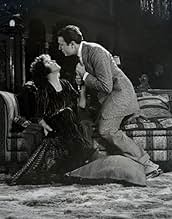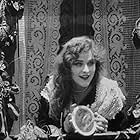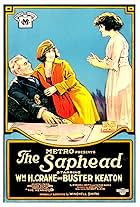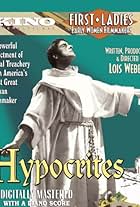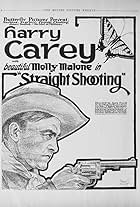A broadway actress uses her sex appeal to ruin a marriage only to dump her lover for a richer prospect.A broadway actress uses her sex appeal to ruin a marriage only to dump her lover for a richer prospect.A broadway actress uses her sex appeal to ruin a marriage only to dump her lover for a richer prospect.
- Director
- Writer
- All cast & crew
- Production, box office & more at IMDbPro
Storyline
Did you know
- TriviaIn a print ad for this film, it was being billed as "SEX CRUSHED TO EARTH" (Pittsburgh ((Penna.)) Press, 29 August 1920)
- Quotes
Adrienne Renault: You only live once, kid. Grab everything you can get and never feel sorry for anyone but yourself.
- ConnectionsFeatured in Alice Guy, 1st Female Filmmaker (2021)
Featured review
I think anyone with an interest in cinema history and also with genuine appreciation of early films (not inclined that is to think in terms, now thankfully outmoded, of waxwork actors and "silent relics") will be impressed with how good this film is and will be surprised it is so little known.
It follows in some ways in the lineage of the classic Theda Bara vamp film of 1914, A Fool There Was, but that film, by contrast, is rather over-rated on account of its historical importance and is a much less believable account of a vamp (Yevgeny Bauer's 1914 Ditya bolshogo goroda/Child of a Big City is a rather better film on the same subject). But both these films portray the "vamp" as a horror (A Fool There Was following Kipling's somewhat mysogynist poem), even if the Bauer, unlike the Bara film, does place the behaviour of the woman in a believable social context.
Glaum's vamp in this film is a much more sympathetic character. She is for a start as much victim as predator, an aspect that had come to the fore in later in more nuanced versions of the vamp (Pastrone's Tigre Real 1916 for instance is already a case in point). In fact Glaum is less like a vamp here and more like the quasi-feminist heroines of some films of the early thirties (the 1933 Baby Face is probably the best) before the more formal enforcement of the Hays Code made it rather more difficult to portray "immoral" women as simply individuals battling to survive in an unequal world (from a point of view both of class and gender).
The film is framed as an "exploitation" film (and the producer Paker Read was already something of a specialist) but this is already a device necessary, particularly in US films, to avoid censorship. Which it did very successfully in this case. The film met with a bit of flack but received rave notices with the papers carefully utilising the supposed "moral" aspect of the film to justify it while at the same time praising the honesty of Read's approach. One can find a very interesting sample of these reviews in the appropriate Wikipedia entry.
Finally praise for the mise en scène which is unusually good for a US film of this period (reminiscent of the more "realist" Italian films of the period). There is a fine scene for instance where Daisy, the vamp's naive protégée, is in the foreground watching events unfold amongst the triangle of main characters deep in the background, two rooms beyond. The copy that I saw is rather poor and this is a film that could certainly do with sympathetic restoration in which case I do not doubt it would be regarded as rather more of a classic than a relic.
As for the ending of the film, it is rather truer to life than those of the thirties films where reform after marriage is its own romantic reward. Here the more melodramatic possibilities are sensibly avoided, the vicious circle is well portrayed and there are worse punishments than being a lonely but wealthy woman cruising around the world.
Fred Niblo is an undeservedly forgotten direct, responsible five years later for quite the best film version of the Lew Wallace novel Ben-Hur.
It follows in some ways in the lineage of the classic Theda Bara vamp film of 1914, A Fool There Was, but that film, by contrast, is rather over-rated on account of its historical importance and is a much less believable account of a vamp (Yevgeny Bauer's 1914 Ditya bolshogo goroda/Child of a Big City is a rather better film on the same subject). But both these films portray the "vamp" as a horror (A Fool There Was following Kipling's somewhat mysogynist poem), even if the Bauer, unlike the Bara film, does place the behaviour of the woman in a believable social context.
Glaum's vamp in this film is a much more sympathetic character. She is for a start as much victim as predator, an aspect that had come to the fore in later in more nuanced versions of the vamp (Pastrone's Tigre Real 1916 for instance is already a case in point). In fact Glaum is less like a vamp here and more like the quasi-feminist heroines of some films of the early thirties (the 1933 Baby Face is probably the best) before the more formal enforcement of the Hays Code made it rather more difficult to portray "immoral" women as simply individuals battling to survive in an unequal world (from a point of view both of class and gender).
The film is framed as an "exploitation" film (and the producer Paker Read was already something of a specialist) but this is already a device necessary, particularly in US films, to avoid censorship. Which it did very successfully in this case. The film met with a bit of flack but received rave notices with the papers carefully utilising the supposed "moral" aspect of the film to justify it while at the same time praising the honesty of Read's approach. One can find a very interesting sample of these reviews in the appropriate Wikipedia entry.
Finally praise for the mise en scène which is unusually good for a US film of this period (reminiscent of the more "realist" Italian films of the period). There is a fine scene for instance where Daisy, the vamp's naive protégée, is in the foreground watching events unfold amongst the triangle of main characters deep in the background, two rooms beyond. The copy that I saw is rather poor and this is a film that could certainly do with sympathetic restoration in which case I do not doubt it would be regarded as rather more of a classic than a relic.
As for the ending of the film, it is rather truer to life than those of the thirties films where reform after marriage is its own romantic reward. Here the more melodramatic possibilities are sensibly avoided, the vicious circle is well portrayed and there are worse punishments than being a lonely but wealthy woman cruising around the world.
Fred Niblo is an undeservedly forgotten direct, responsible five years later for quite the best film version of the Lew Wallace novel Ben-Hur.
Details
- Runtime1 hour 27 minutes
- Color
- Sound mix
- Aspect ratio
- 1.33 : 1
Contribute to this page
Suggest an edit or add missing content








